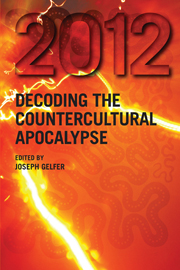Book contents
- Frontmatter
- Contents
- Contributors
- Preface
- 1 Introduction
- 2 The 2012 Phenomenon: New Uses for an Ancient Maya Calendar
- 3 Maya Prophecies, 2012 and the Problematic Nature of Truth
- 4 Mayanism Comes of (New) Age
- 5 The 2012 Milieu? Hybridity, Diversity and Stigmatised Knowledge
- 6 Chichén Itzá and Chicken Little: How Pseudosciences Embraced 2012
- 7 Roland Emmerich's 2012: A Simple Truth
- 8 The 2012 Movement, Visionary Arts and Psytrance Culture
- 9 In a Prophetic Voice: Australasia 2012
- 10 Approaching 2012: Modern Misconceptions versus Reconstructing Ancient Maya Perspectives
- Notes
- Index
1 - Introduction
- Frontmatter
- Contents
- Contributors
- Preface
- 1 Introduction
- 2 The 2012 Phenomenon: New Uses for an Ancient Maya Calendar
- 3 Maya Prophecies, 2012 and the Problematic Nature of Truth
- 4 Mayanism Comes of (New) Age
- 5 The 2012 Milieu? Hybridity, Diversity and Stigmatised Knowledge
- 6 Chichén Itzá and Chicken Little: How Pseudosciences Embraced 2012
- 7 Roland Emmerich's 2012: A Simple Truth
- 8 The 2012 Movement, Visionary Arts and Psytrance Culture
- 9 In a Prophetic Voice: Australasia 2012
- 10 Approaching 2012: Modern Misconceptions versus Reconstructing Ancient Maya Perspectives
- Notes
- Index
Summary
The Road to 2012
Recently I was at my local cinema—the Sunshine Village Cinema, to be exact—in Melbourne's western suburbs. The air was a fug of noodles and KFC from the adjoining food court, the amusement arcade hammering noise like a battleground. The foyer was thick with hooded youths armed with super-sized drinks, plus a sprinkling of gold-class tickets holders on their way to their more exclusive foyer serviced with sparkling wine and nibbles. We were there to see John Cusack save the world in Roland Emmerich's blockbuster 2012, the one with the waves overtopping the Himalaya and engulfing a remote Buddhist monastery. It's a long way from Maya prophecy, on which the 2012 phenomenon is said to be based, to the Sunshine Village Cinema; a long way, even, from my own recent awareness of 2012. “How did you first hear of 2012?” is one of the first questions researchers of the subject tend to ask. Let me briefly sketch my own journey to this point.
I came to 2012 relatively late in the game, in 2003. I had read Daniel Pinchbeck's Breaking Open the Head (2002) in which the author documents his psychedelically-inspired awakening to a world beyond his previously rationalistic and journalistic mindset.
- Type
- Chapter
- Information
- 2012Decoding the Countercultural Apocalypse, pp. 1 - 7Publisher: Acumen PublishingPrint publication year: 2012

